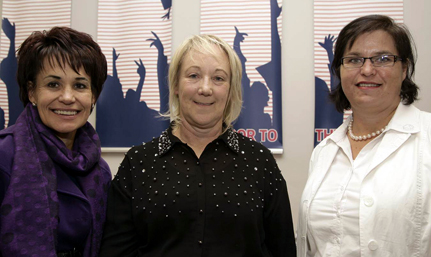 |
Some of the guests attending the launch, included from left: Prof Driekie Hay, Vice-Rector: Academic, Dr Henriette van den Berg, Director: Postgraduate School and Prof Corli Witthuhn, Vice-Rector: Research.
10 May 2013
Photo: Johan Roux |
Postgraduate students and their academic 'parents' at the University of the Free State (UFS) now have a dedicated physical, emotional and electronic space to provide for their specialised needs in order to further promote research excellence at the UFS.
The university's Postgraduate School was launched in May 2011, but ventured further in the quest to fulfil and expand its mandate with new initiatives. These different aspects of the school were launched on Wednesday 8 May 2013 in the CR Swart Auditorium on the Bloemfontein Campus. The postgraduate strategy, postgraduate prospectus, the website and the headquarters of the Postgraduate School in the Johannes Brill Building were all unveiled and launched.
Prof Driekie Hay, Vice-Rector: Academic, who was a major driving force behind the formation of the Postgraduate School, during her address at the opening emphasised the multifaceted and unique relationships which often exist between students and supervisors.
Prof Hay, who has a distinguished academic background in postgraduate teaching, made plain her expectations for the Postgraduate School. She said it aims to "create an intellectual space for postgraduate students and supervisors" in order to produce world-class intellectuals at this university.
She said the school will empower both students who often don't know what to expect from supervision, as well as supervisors who often lack supervision skills. Through this it will be possible to create healthy, productive relationships between the distinct pairs in often misunderstood, unbalanced and intricate interactions.
Dr Henriette van den Berg, Director of the Postgraduate School, introduced the strategic plan of the school and emphasised the great strides that have already been made and what still needs to be done at the UFS in terms of postgraduate teaching. According to her, the Postgraduate School aims towards "holistic development of postgraduate students with transferable skills," through a multi-level and institution-wide approach at the university.
"Our aim is to develop a one-step service for postgraduate students, involving all the different stakeholders," she said.
The new Postgraduate School website was also showcased during the event. Reachable through a number of avenues on the main website, the site offers a digital version of the Johannes Brill Building. Brimming with features catering specifically for local, international, current and prospective students, the website provides crucial information.
The Johannes Brill Building's refurbished interior, with staff offices, seminar rooms and social spaces, were also showcased to UFS' staff and students. The initial phase of the Supervisors' Wall of Fame was also unveiled. According to Dr van den Berg , the wall will after completion bestow much-deserved praise on a hand-picked group of 60 supervisors who have respectively been responsible for more than 300 and more than 500 successful PhD and master's candidates over the past decade.